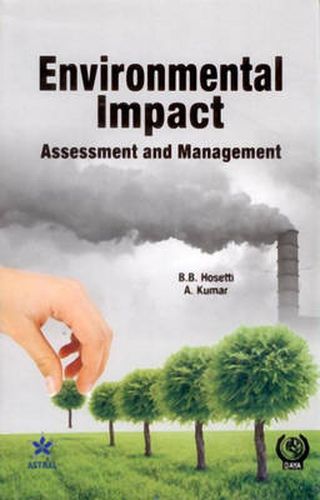Readings Newsletter
Become a Readings Member to make your shopping experience even easier.
Sign in or sign up for free!
You’re not far away from qualifying for FREE standard shipping within Australia
You’ve qualified for FREE standard shipping within Australia
The cart is loading…






This title is printed to order. This book may have been self-published. If so, we cannot guarantee the quality of the content. In the main most books will have gone through the editing process however some may not. We therefore suggest that you be aware of this before ordering this book. If in doubt check either the author or publisher’s details as we are unable to accept any returns unless they are faulty. Please contact us if you have any questions.
This book entitled Environmental Impact Assessment and Management, embodies 15 chapters covering a wide spectrum. Chapter 1 contains details of EIA, Basic elements and Methodologies. Further, important guidelines to be followed before establishing industries, water related projects and transport related projects are narrated in Chapter 2. Important case studies of EIA viz, second stage expansion of Malpe fishing harbour, Human impact on Himalayan Ecosystem, Konkan Railway Project, Heavy metal pollution in the Coovum river, an impact prediction for an irrigation project and impact of cement making on the air quality of Coimbatore, are dealt in Chapter 3. Once a project comes into existence, it results in side effects of the immediate environment which are evident on the consecutive 5-10 years of operation. Therefore, its efficiency and pollution abatement systems should be checked and corrected in a manner similar to financial auditing and this aspect has been incorporated in Chapter 4. Now-a-days due to the rapid process of urbanization, all the cities of India have accumulated a lot of filth leading to ghasty smell, loss of property value and the spread of diseases. In order to have a clean environment, we have to have a systematic refuse management package for Indian conditions. As illustrations of this view, the urban solid waste management in Hyderabad, Shimoga and Rourkee cities have been explained in the Chapter 5 and 6 respectively. The consecutive chapters deal on various other aspects such as coastal zone management, deforestation, impact of mining on fisheries, wild life management, termite pest control, bioremediation of wastes by hydrophytes, role of remote sensing in EIA, Kaiga environment and management of food protection.
$9.00 standard shipping within Australia
FREE standard shipping within Australia for orders over $100.00
Express & International shipping calculated at checkout
This title is printed to order. This book may have been self-published. If so, we cannot guarantee the quality of the content. In the main most books will have gone through the editing process however some may not. We therefore suggest that you be aware of this before ordering this book. If in doubt check either the author or publisher’s details as we are unable to accept any returns unless they are faulty. Please contact us if you have any questions.
This book entitled Environmental Impact Assessment and Management, embodies 15 chapters covering a wide spectrum. Chapter 1 contains details of EIA, Basic elements and Methodologies. Further, important guidelines to be followed before establishing industries, water related projects and transport related projects are narrated in Chapter 2. Important case studies of EIA viz, second stage expansion of Malpe fishing harbour, Human impact on Himalayan Ecosystem, Konkan Railway Project, Heavy metal pollution in the Coovum river, an impact prediction for an irrigation project and impact of cement making on the air quality of Coimbatore, are dealt in Chapter 3. Once a project comes into existence, it results in side effects of the immediate environment which are evident on the consecutive 5-10 years of operation. Therefore, its efficiency and pollution abatement systems should be checked and corrected in a manner similar to financial auditing and this aspect has been incorporated in Chapter 4. Now-a-days due to the rapid process of urbanization, all the cities of India have accumulated a lot of filth leading to ghasty smell, loss of property value and the spread of diseases. In order to have a clean environment, we have to have a systematic refuse management package for Indian conditions. As illustrations of this view, the urban solid waste management in Hyderabad, Shimoga and Rourkee cities have been explained in the Chapter 5 and 6 respectively. The consecutive chapters deal on various other aspects such as coastal zone management, deforestation, impact of mining on fisheries, wild life management, termite pest control, bioremediation of wastes by hydrophytes, role of remote sensing in EIA, Kaiga environment and management of food protection.